We had to pick up our Otakuthon badges in person on Friday morning because the US Postal Service changed regulations for items in bubble mailers containing badges with RFID chips, so the badges could not be mailed as planned. [Also Otakuthon did not get its shit together to mail the badges early enough.]
While we waited in le Palais, we took pictures of our dolls hanging out near an art installation of pink trees, Nature legere. Lyra’s doll is a Volks Yo-SD Kira. Mine are Toon Silence and Toon Ethan. I also got a shot of Toon Silence and Toon Ethan both trying to enter the con under a single badge [mine] and the extremely long line in front of Tim Hortons, a very popular fast food place for Canadians, which is the Canadian equivalent of Dunkin Donuts [i.e., cheap and ubiquitous]. Pictures below. Click a picture to enlarge it.
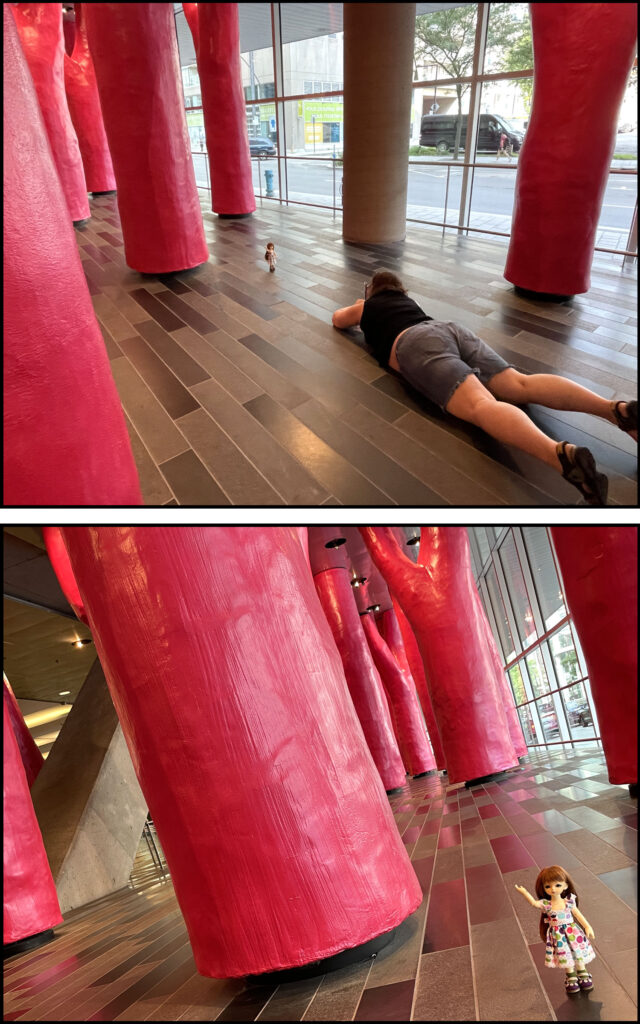
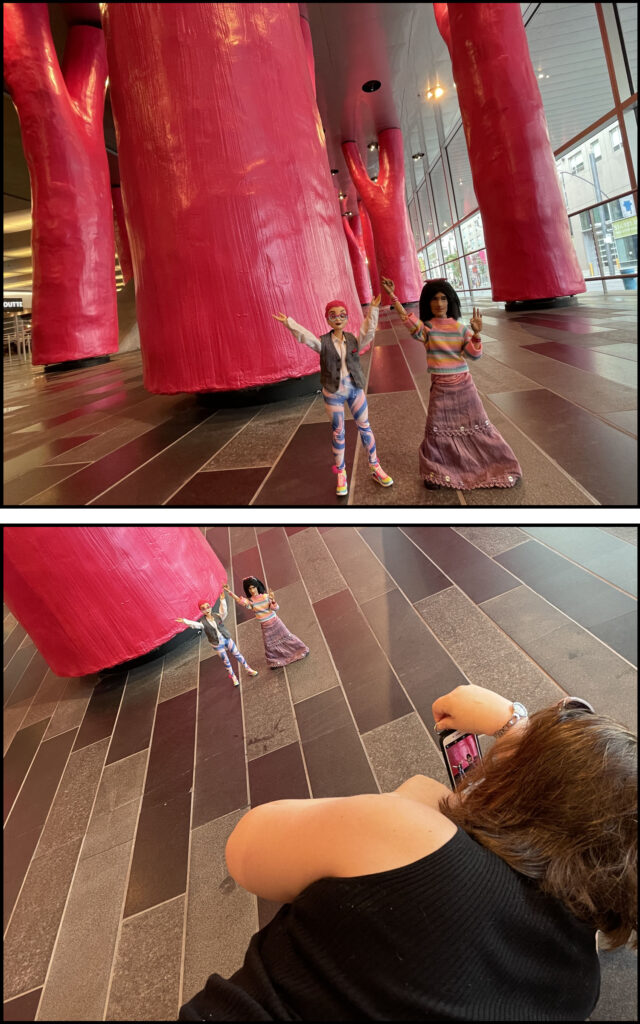
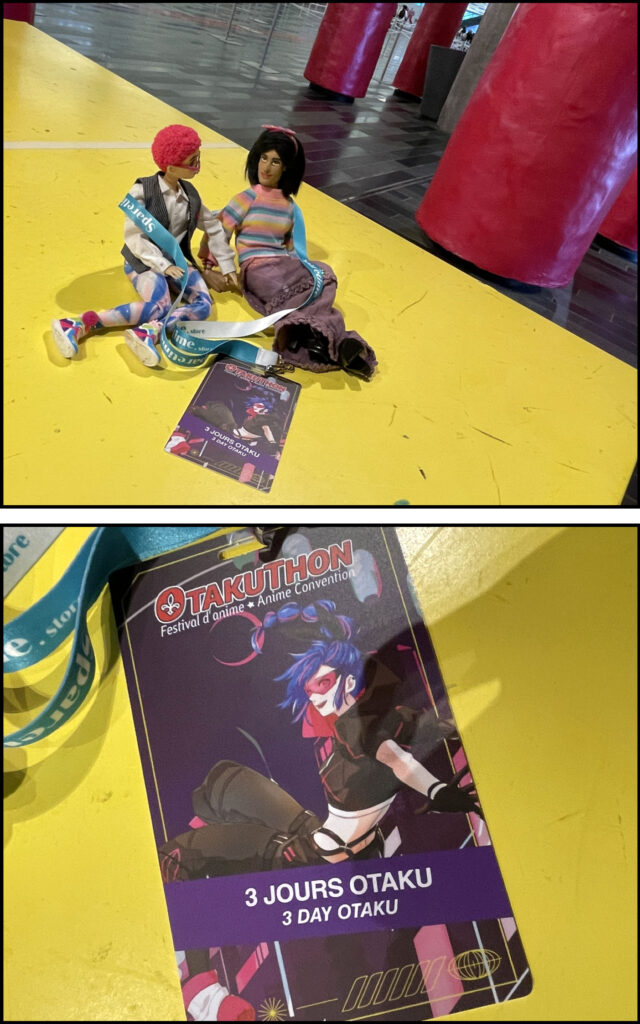

After we got our badges, programming didn’t start for a while, so we wandered around Chinatown. The first three photos represent the increasing gentrification of Chinatown, which I have documented in past shots of Otakuthon. This building on the Rue de la Gauchetiere has at least two residential floors and people living there, but, as the second picture shows, there’s a realtor’s FOR SALE sign on it. On the third floor balcony, a bilingual protest banner states, “This is my home! I’m here, and I’m staying here!” In other words, the tenant wants to stay in the building as long as possible!
Our dolls hung out in Sun Yat Sen Park, took over Coco’s extra large bubble tea, and hung out with the foo dogs near the Boulevard Saint-Laurent gates to Chinatown. Lyra took my photo there too! Photos below.
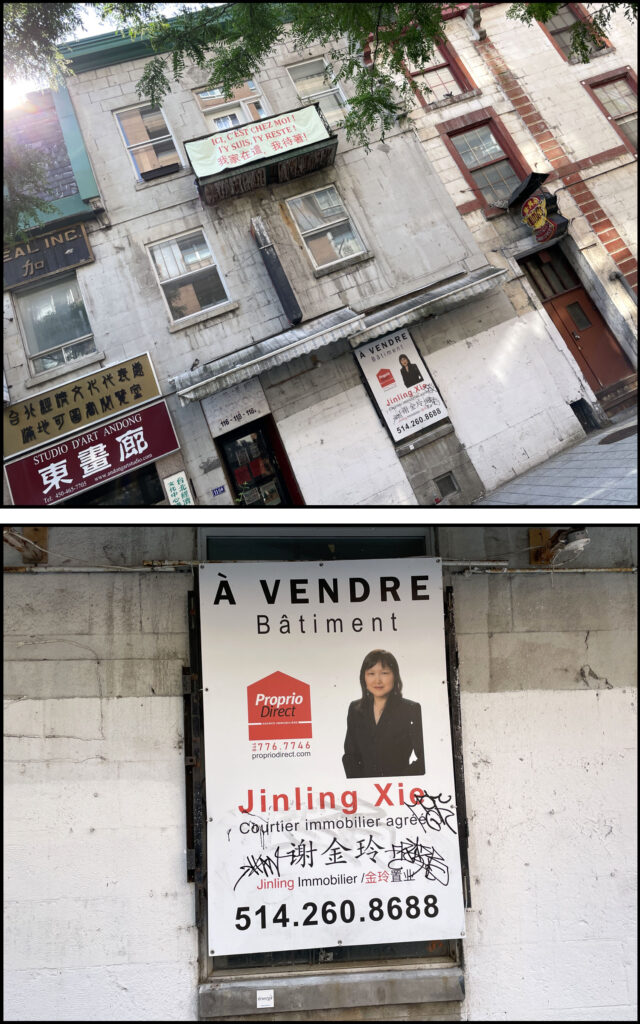
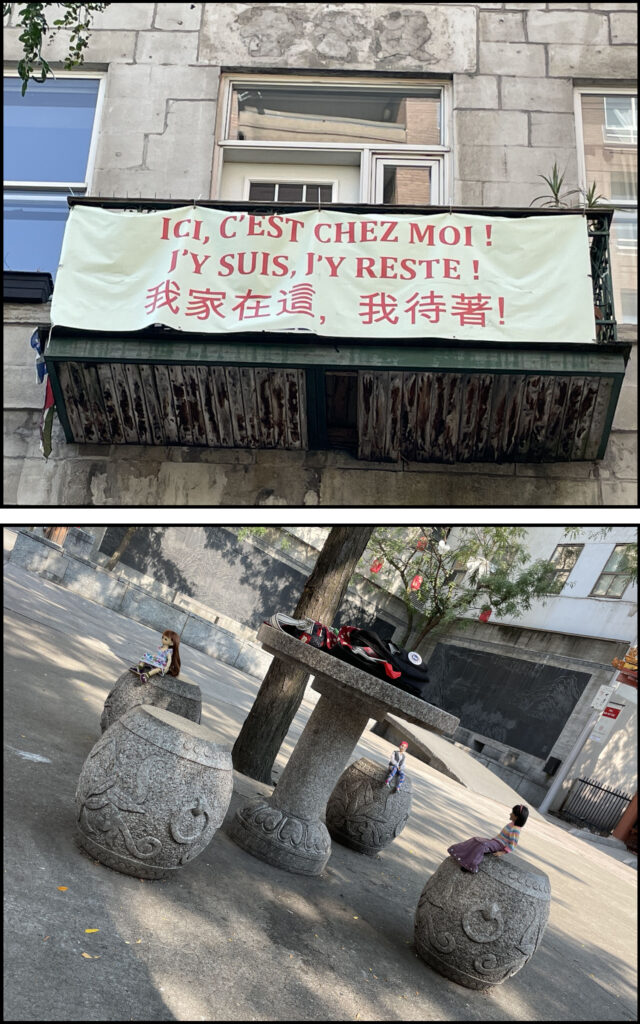
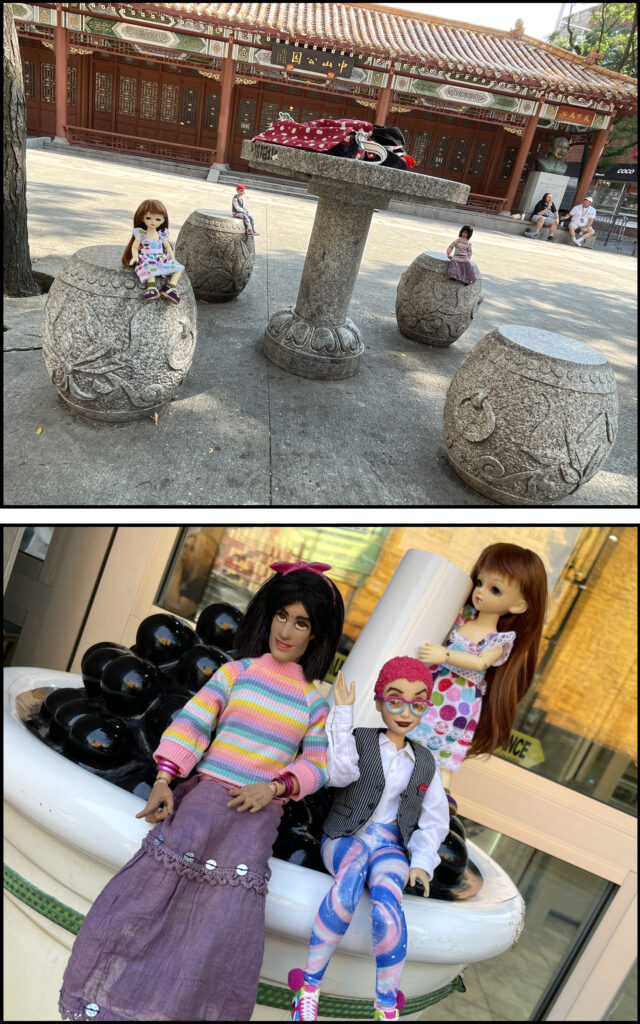
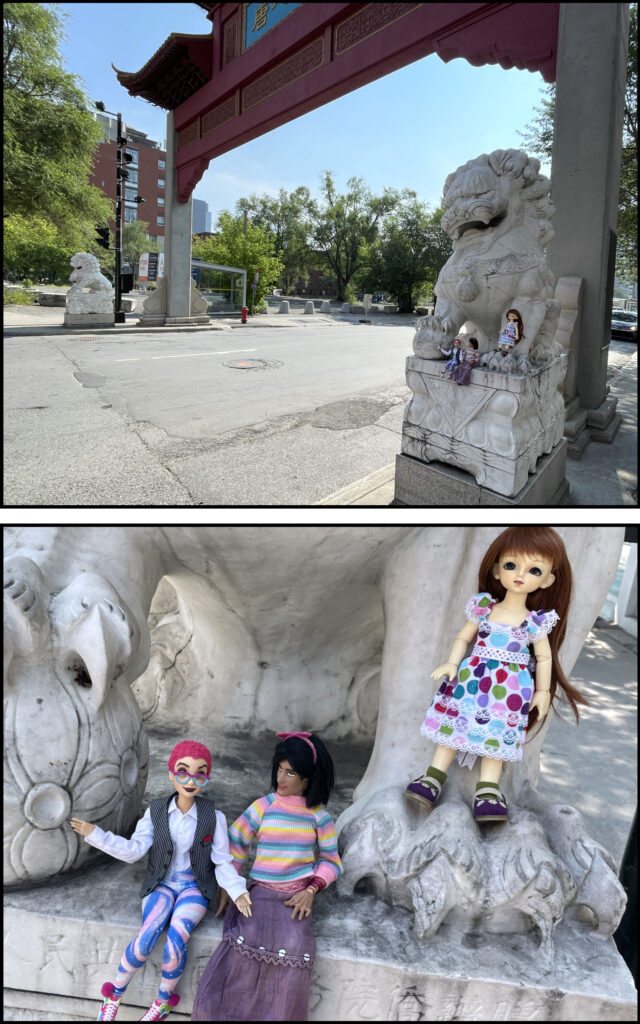
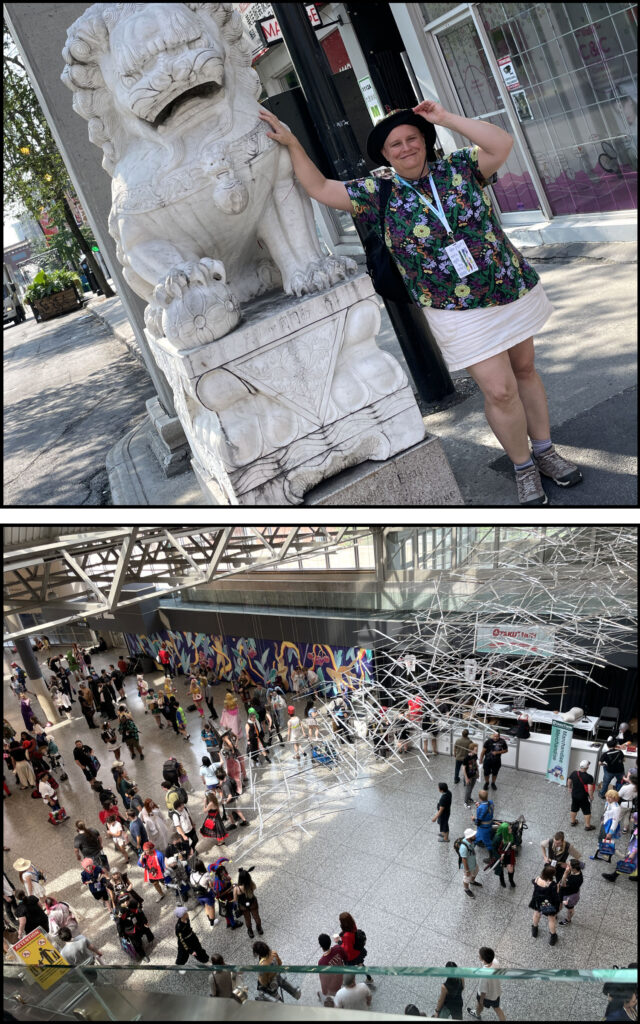
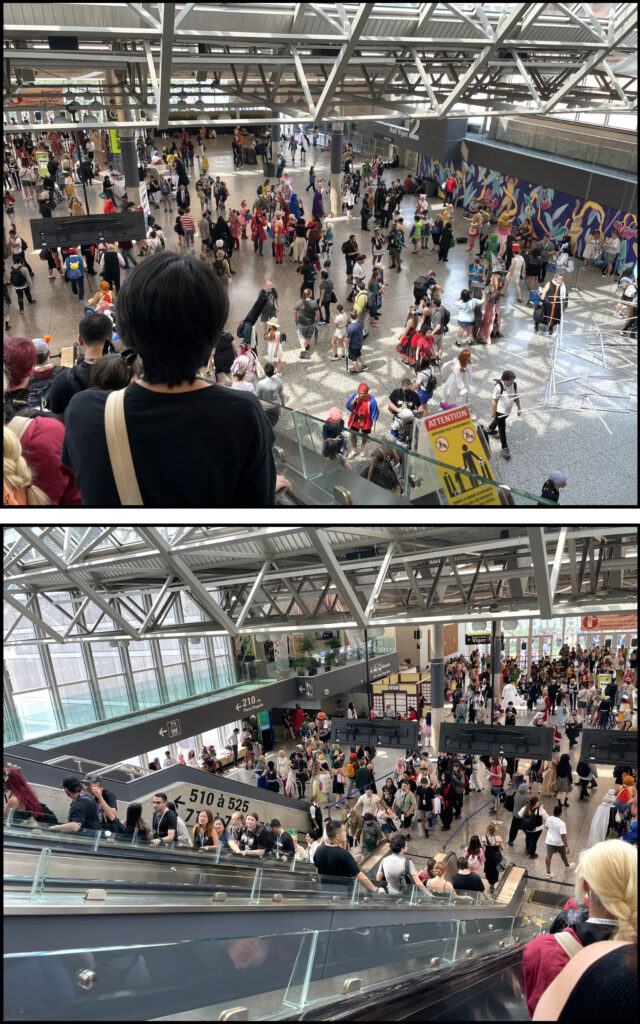
I took some photos to try to give a sense of the scale of Otakuthon. Now Canada’s largest anime convention [surpassing even Toronto’s Anime North], the event basically occupies the entire Palais for the three days it runs. I took pictures [the last three above] while descending the escalator from the fifth floor to Hall Viger, on the second floor. In Hall Viger, people were entering from the street and posing for cosplay photos, so the hordes coalesced here.
The dealer room, containing both corporations and individual artists, seemed much more crowded than in previous years. Many conventioneers just stopped and stood in the middle of aisles, much to my annoyance. However, I passed a significant amount of time there, exclusively in the area for individual artists.
First I circulated with my camera, asking if I could take photos of booths with artists whose work I liked. Everyone consented enthusiastically. After identifying the artists I liked on a complete tour of the artists’ alley, I returned to my most favorites and bought a few things. This was a much better idea that impulsively purchasing from people as I encountered them, which I have done in previous years!
A well-designed artist’s booth with professional-looking displays and a coherent design will always draw attention, so obviously anitartlet’s booth caught my eye. I appreciated this artist’s bright, saturated colors and the juxtaposition of things both cute and slimy. In the photos below, the cat with mouth suckers, the noodles made out of eels [on the artist’s T-shirt], and the capsule vending machine with eyeballs represent this playful sense of humor. From this artist I purchased a small print of a purple-haired girl with sea creatures behind her and a bunch of sparkly stickers. Many of the stickers combine human profiles with succulent-like plants for hair or hats. Click any photo to enlarge.
Though “birb” or “borb” is online slang for a round, fat, orb-shaped bird, the Borb Emporium seemed to concentrate more on a cartoony black cat as a chief character. I liked the cute character frolicking among glowing landscapes saturated with jewel tones. The black cat also appeared on many small stickers with various agitated expressions and funny captions. Besides “Don’t ask me where I’m going (I’m going insane),” I also liked “SPITE.” and “AWAKE but at what cost.” I got a small print of the black cat going through a portal against a purple sky for @natalunasans and the “(I’m going insane)” sticker.
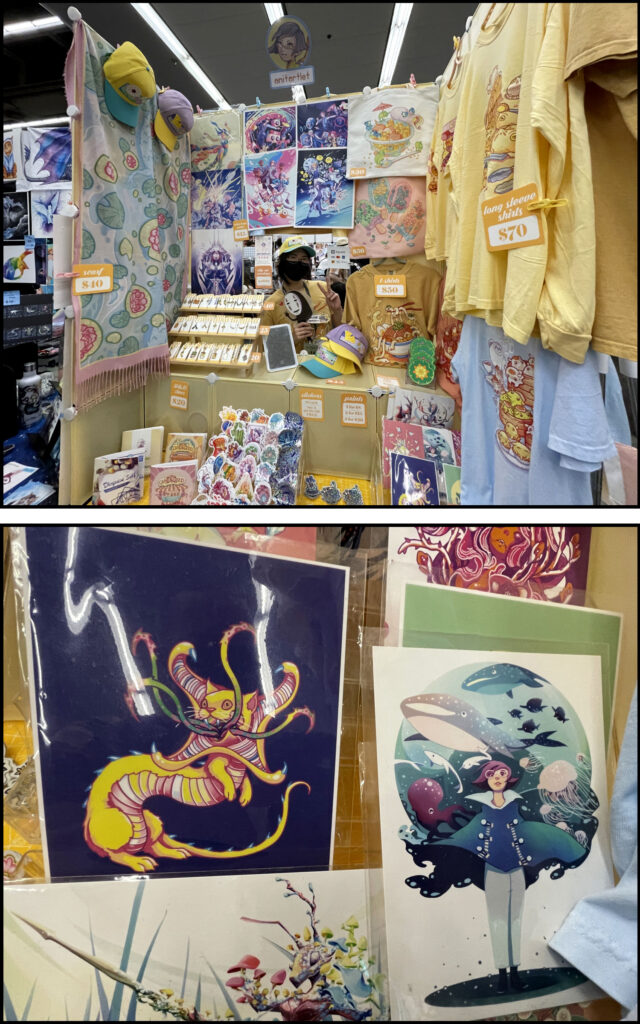
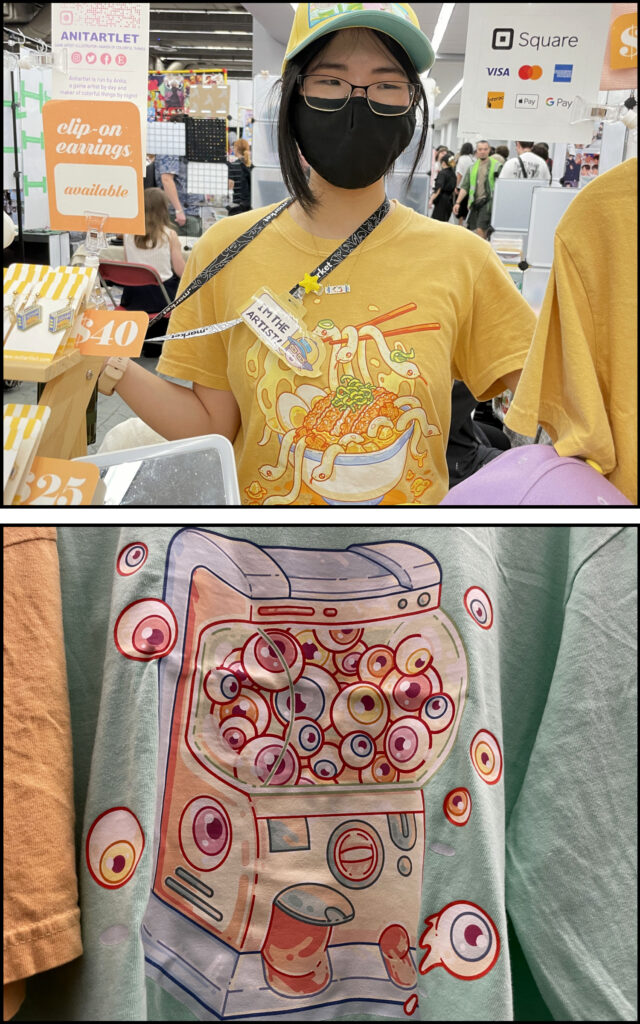
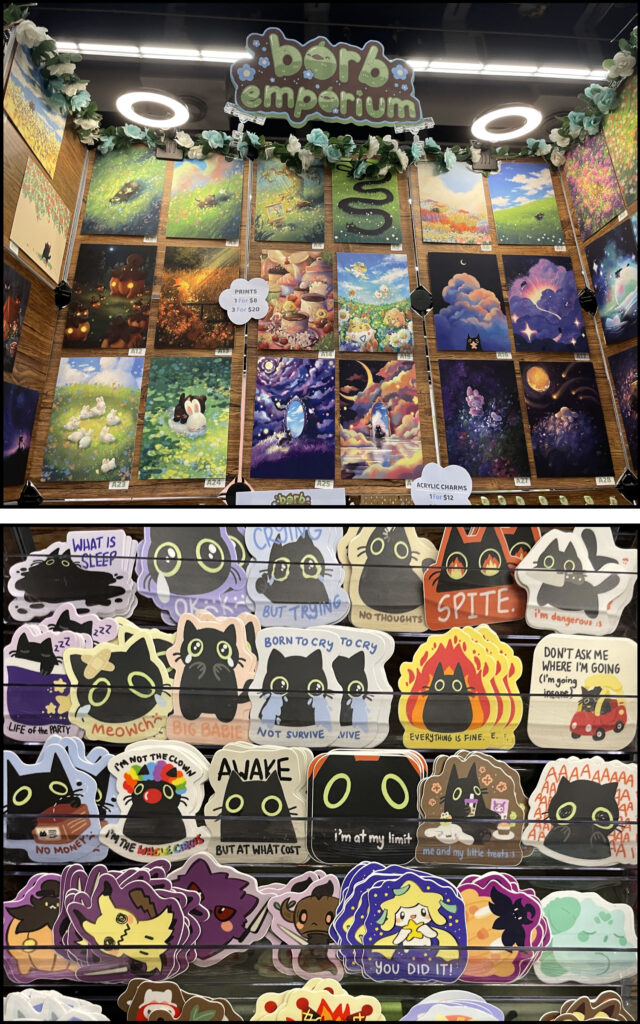
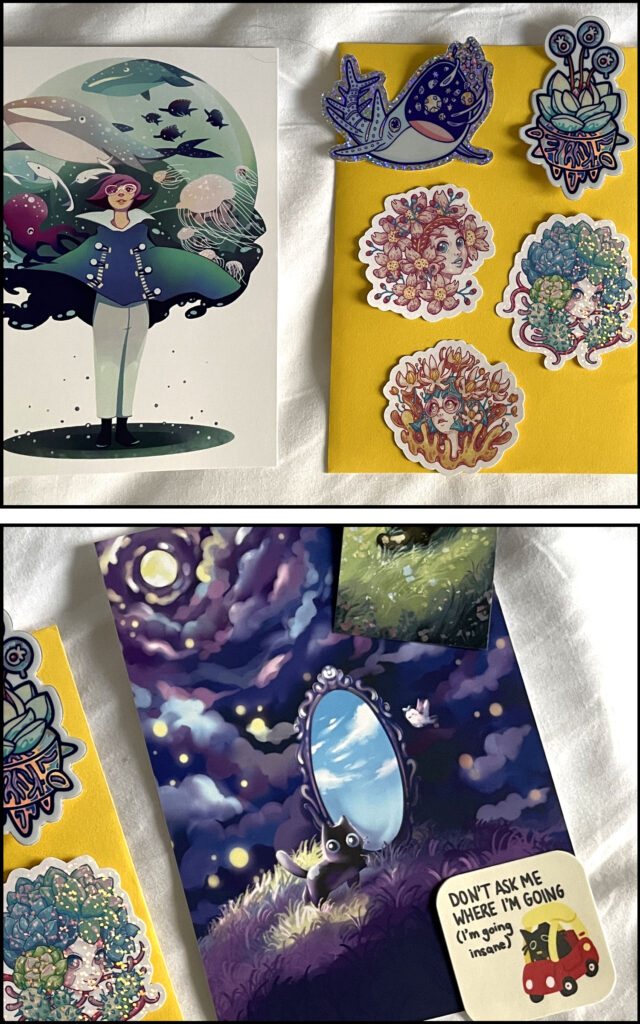
Of all the artists I met, Honeysips [below] definitely had the best booth, with an entablature-like sign that brought everything together, displays that balanced pictures and white space, and convenient racks for stickers and smaller prints, all showcasing the best of her aesthetic. I bought some of her work in 2022 and told her effusively how much I liked it, so I was pleased that she had returned. I got some stickers and two small prints of brown-skinned kids with bee/beekeeper themes. Pictures below. Click to enlarge.
Lisa LaRose’s surreal combinations of subjects [also below] — an astronaut with a goldfish bowl for a helmet or a cat growing fungus — recalled anitartlet, but Lisa LaRose had much more saturated colors and a tendency to realism. I bought my favorite piece of art from the entire Otakuthon here: an 11×17 print of “Snakery Bakery,” with cheerful and vibrant hognose snakes slithering around equally bright frosted doughnuts. It’s unusual; it’s playful; it’s obnoxiously bright, and it will make me smile when I put it on the wall of my office.
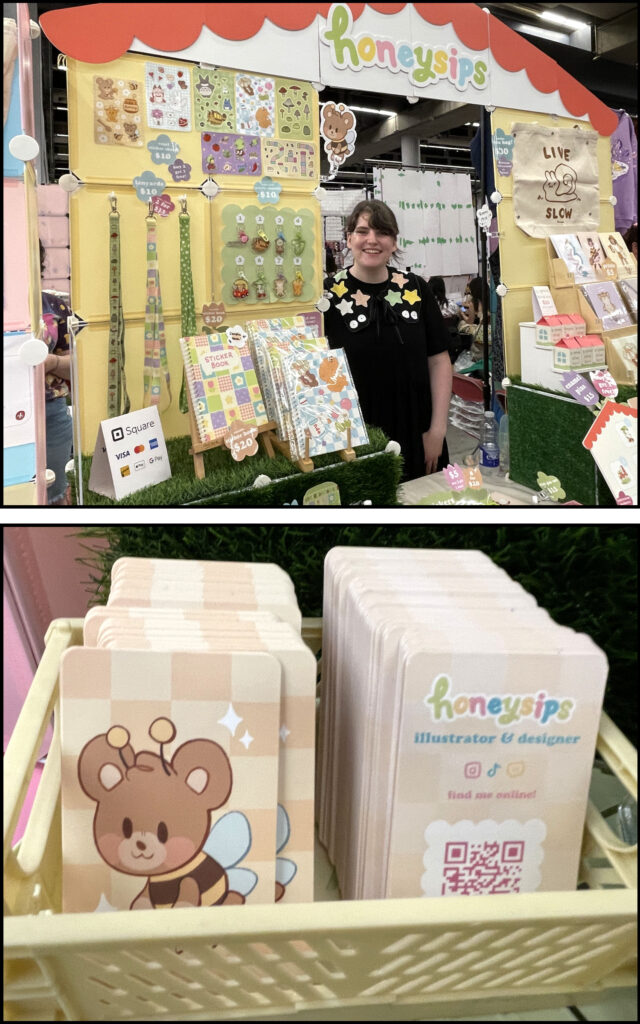
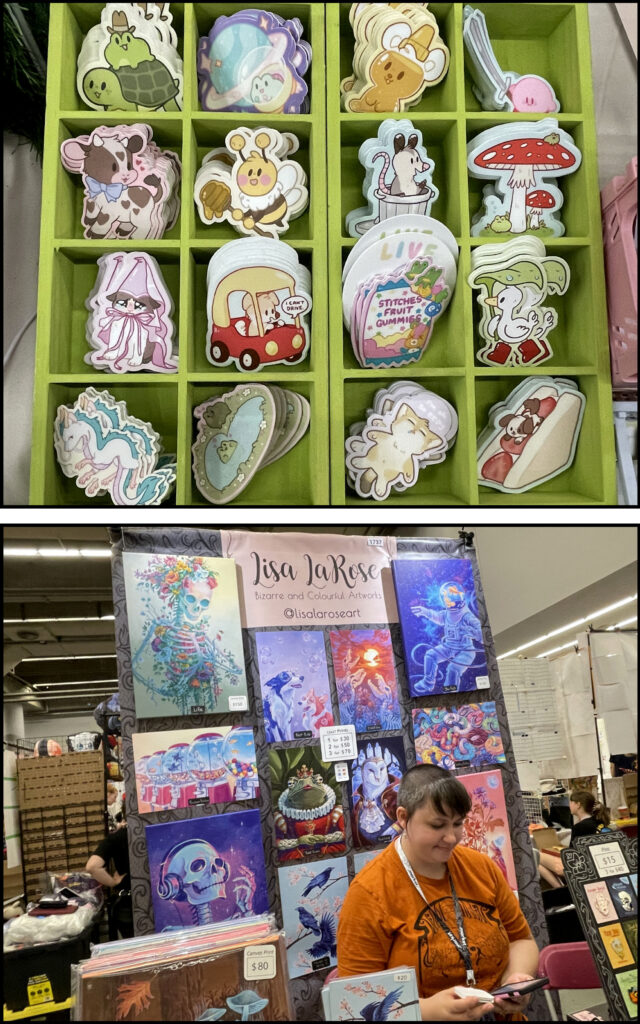
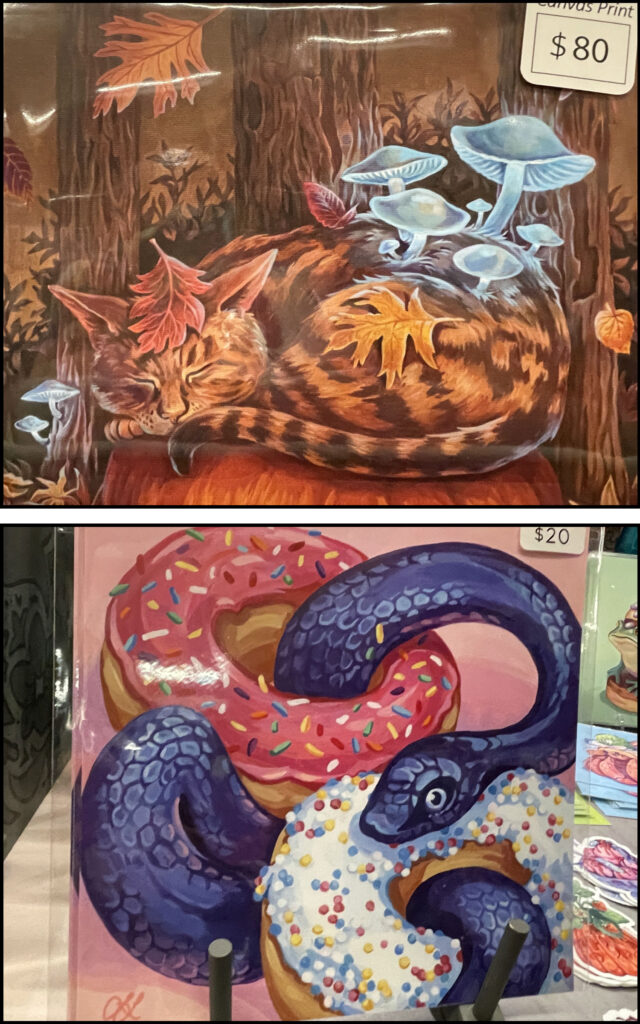

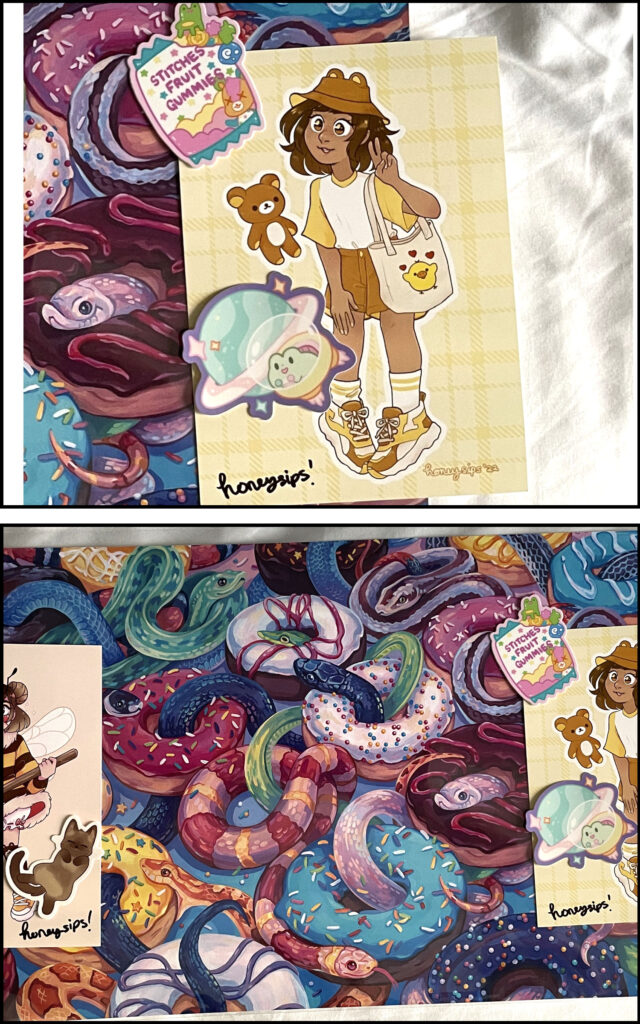
Prismatic Pocket’s booth featured cool blue tones on all the art and even in the artist’s clothing and hair. I liked the eye-catching aesthetic choice and purchased a small print of the very dark-skinned girl in the right of the first photo. However I ended up deciding that I did not like this artist’s work as much as I originally thought I did.
Cianna’s Creations, however, shown in the last four photos below, thoroughly charmed me. The artist, seen grinning in the third photo, was thrilled to talk to me. I loved the artist’s brown-skinned mermaids, including fanart of the actor who played Ariel in Disney’s live-action adaptation of their animated version of The Little Mermaid.
Most of all, I smiled at the artist’s “Polaroid Camera Friends,” a series of four stickers of girls with various shades of brown and golden skin, each making goofy faces while holding a Polaroid camera. So much manga and anime stars characters who are either pale white or very slightly beige, so I love seeing a variety of races and ethnicities represented in fanart and in original characters. The Polaroid Camera Friends are the artist’s original characters. I really like the fat elf with locs sticking out her tongue. I made sure to tell the artist how much I loved the Polaroid Camera Friends stickers!!
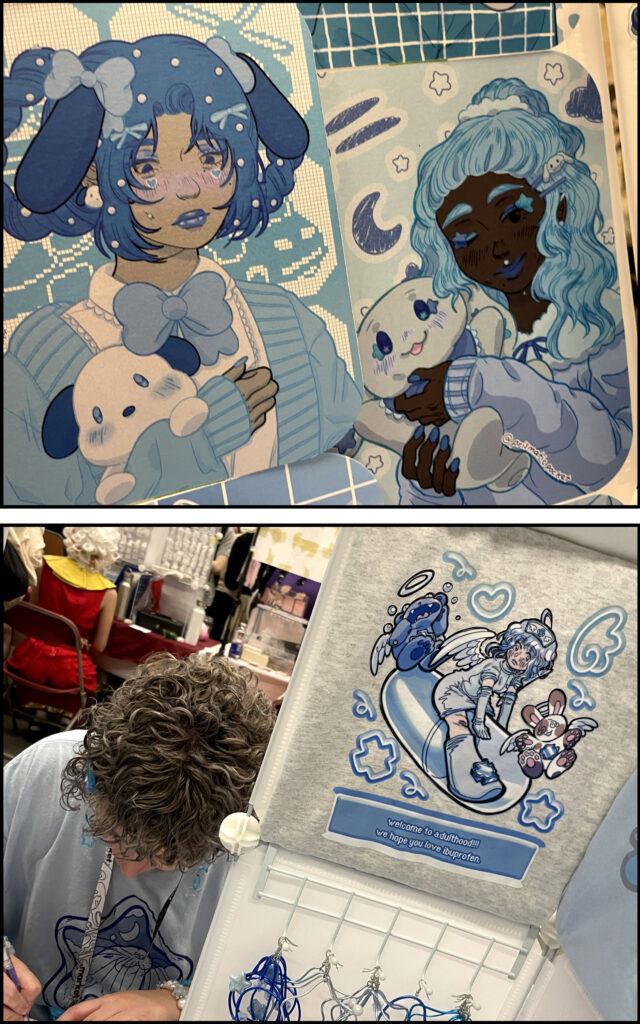
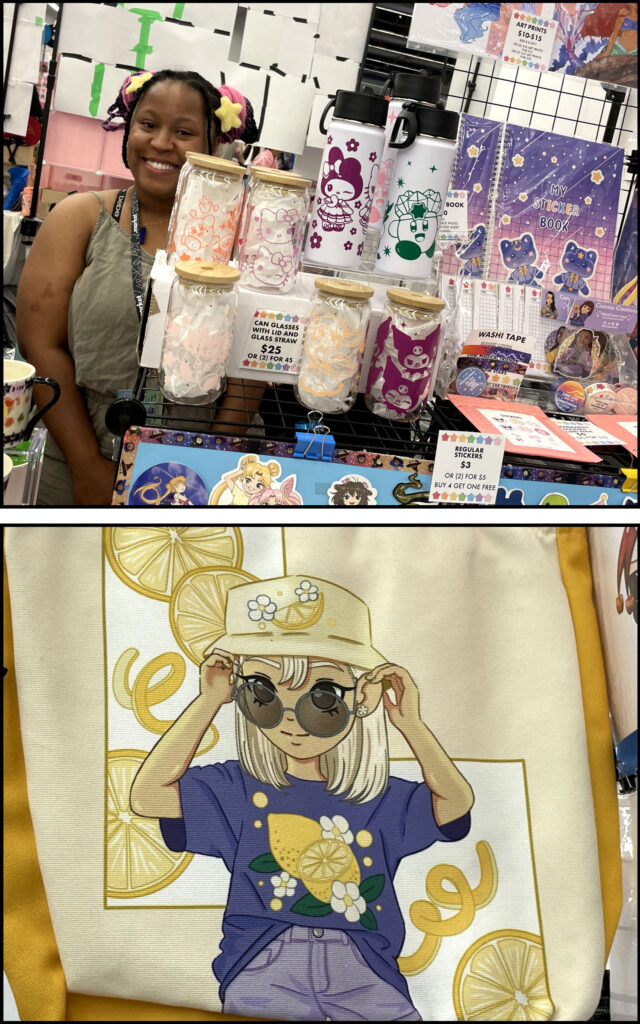
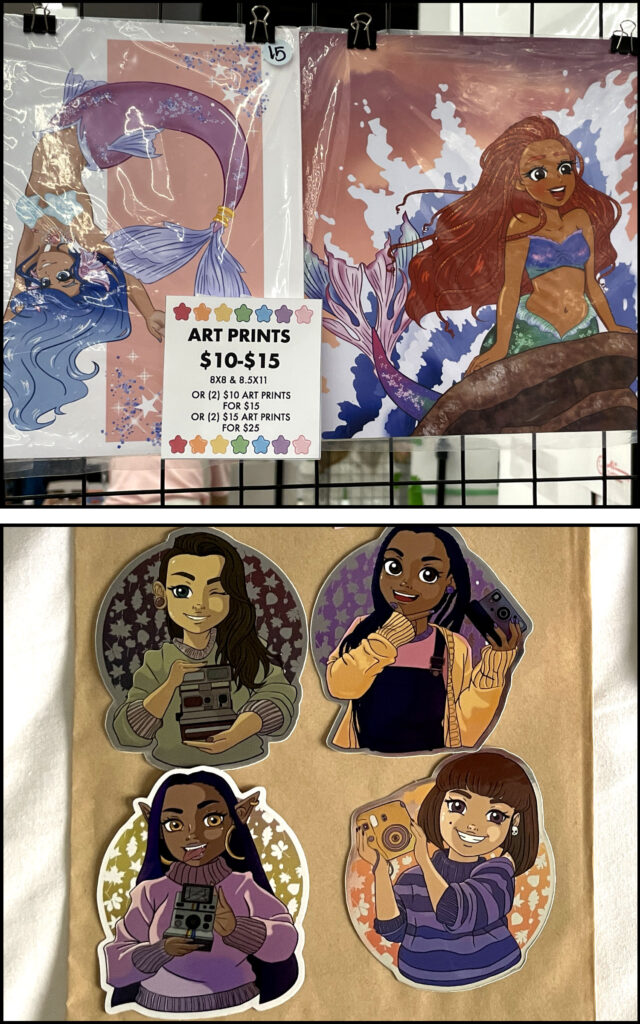
Below, Lilaeleaf’s art all focused on these small, pointy, big-eyed goblins, whose exaggerated suffering reminded me of the Borb Emporium’s little black cat. Of course, as can be seen in the stickers, the goblins had many happy, studious, inspired, fascinated, wonderstruck, thoughtful, and other positive moods, but the sketches of the unhappy goblins made me guffaw out loud. At that point, the artist very proudly showed me that they had made a sculpture of one of the goblins, and “He has a butt!” Naturally I had to get a picture of both the sculpture’s front and its butt. From Lilaeleaf I got the “The lights are loud :C” goblin print.
Doodledlie, also below, interested me because of their experimentation with watercolor, an unusual medium for an anime convention. The artist wanted to tell me all about their redheaded Dungeons and Dragons character who inspires a lot of art [“He lives rent-free in my head!”]; meanwhile I wanted to talk about watercolor and the lovely monochrome palettes, as seen in the print of the girl and the blue jay that I bought as well as the set of six stickers of merpeople. I also bought another sticker sheet of merpeople in a more cartoony style from Doodledlie too.
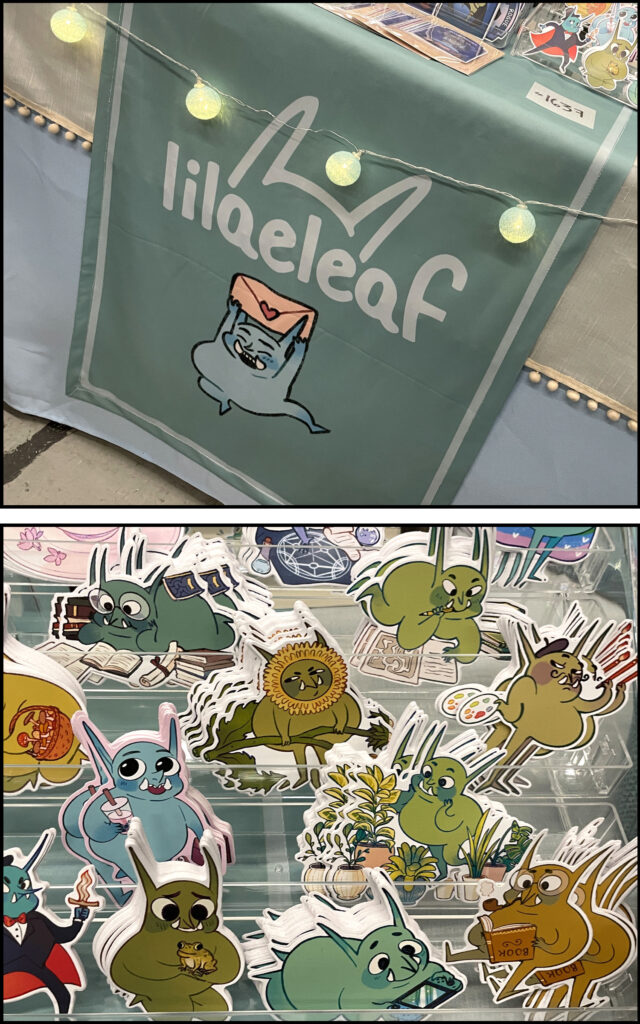
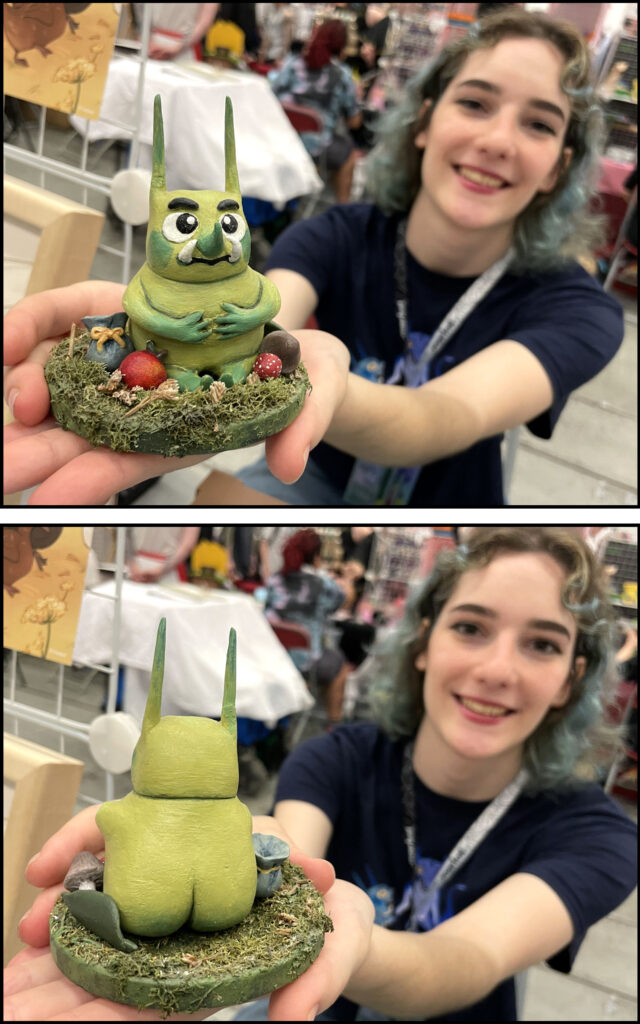
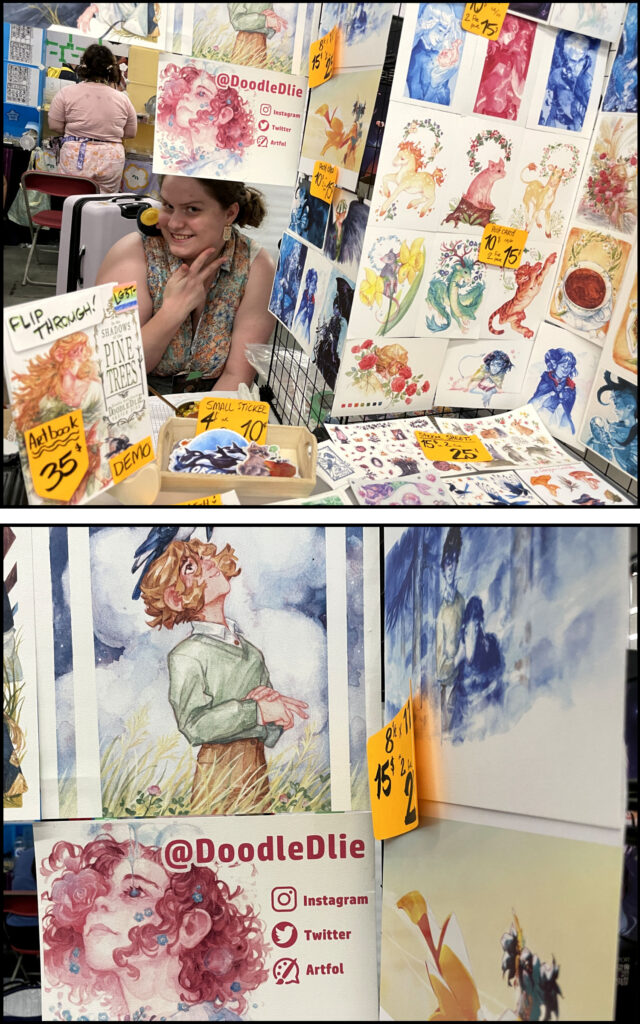
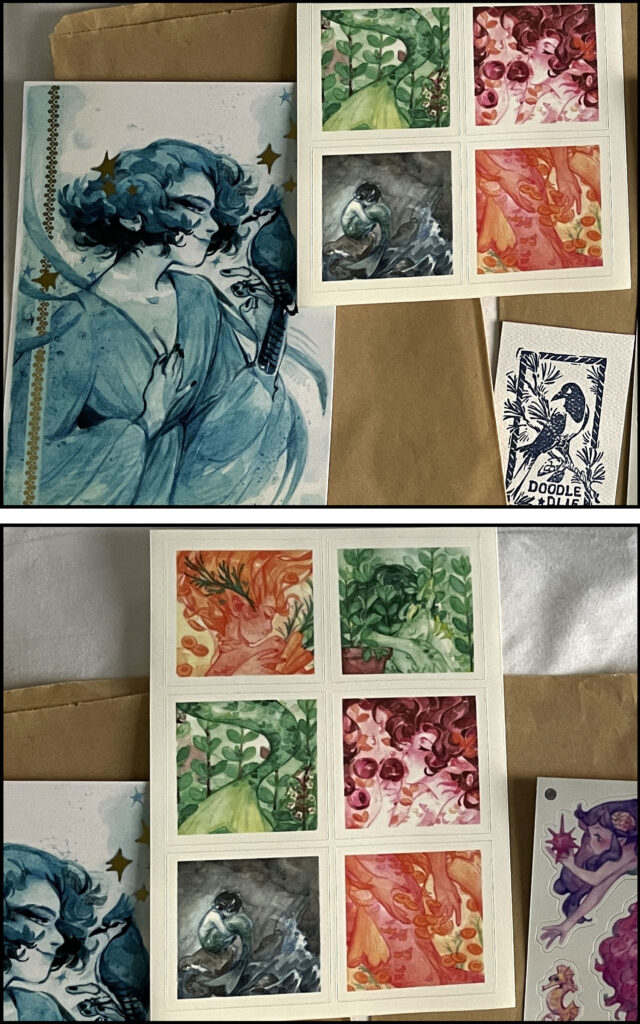
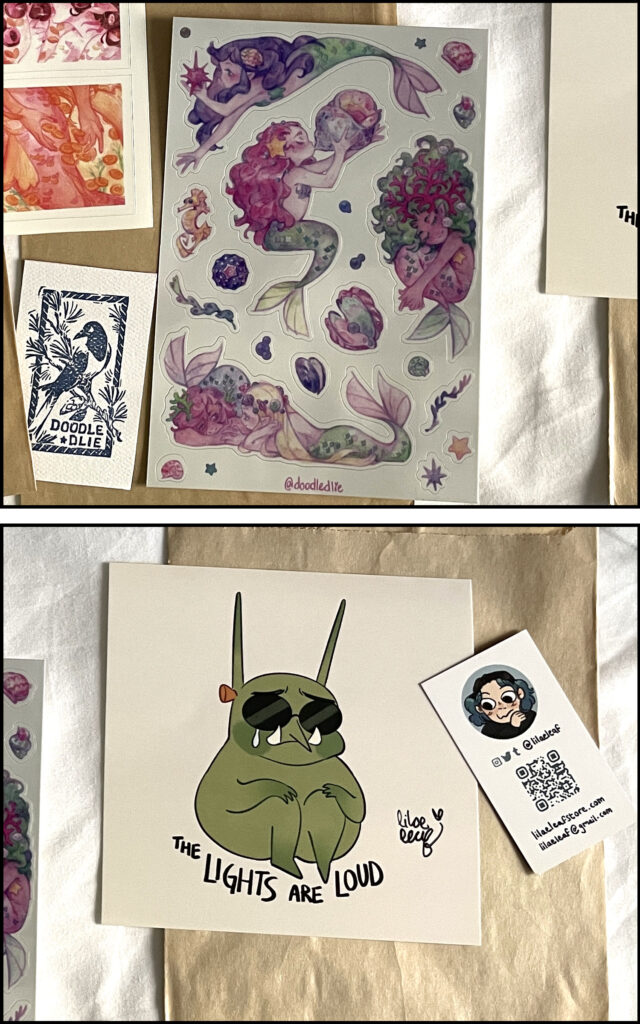
I did not take pictures of the two panels that we attended on Friday. First we listened to a freelance manga translator, Kumar Kivasubramanian, discuss his informal path from consumer of manga and Japanese anime to manga translator. We hadn’t considered attending, but Dollfest programming [focused on BJDs and usually the attraction for us in previous years] didn’t start until much later in the day, so we decided to listen to Kivasubramanian. He told interesting anecdotes about the manga business and the idiosyncrasies of translating in general. Since I am always interested in literature and analyzing language, I thought this was really cool, even though I do not read manga.
After that we listened to a francophone panel contextualizing the history of the Harajuku district as a Japanese fashion crossroads. I found the information interesting, but the presenter read from a screen, very fast, with little personality and no interaction with the audience. He was trying to cram over an hour’s worth of material into 45 minutes, and the presentation suffered.
We much preferred the raucous panel “Toot and Boot: Lolita Fashion.” Two Lolita fashion enthusiasts showed slides of various Lolita outfits and then asked audience members to either “toot” [approve of] or “boot” [condemn] the outfits. The presenters and the audience members chatted with each other, called out, and justified their choices. Once I adjusted to the fact that no one would shut up because the presenters encouraged audience participation, I enjoyed the fashion critique.
Dollfest programming seemed rather sparse this year. We looked in on “Vinyl Dolls 101,” the first BJD-related panel at 5:00 PM on Friday. The topic was nothing new, and the program had become an informal meetup for francophone doll lovers when we arrived. We did not stay too long.
For many of our quick meals, we patronized Coco. We immediately figured out that it was the better of the centrally located Chinatown bakeries to choose from. Being further away from le Palais, it was less mobbed than Patisserie Harmonie, which the hordes descend upon because it’s more convenient. Coco, however, has fewer hordes, a more logically arranged floorplan, and better organization. That’s where we got our standard lunches of one or two onigiri, one or two red bean sesame balls, and some other sweets for filler.
The Japanese modified French concepts of roll cakes [light, airy, sponge cakes spread with cream and often including cut fruit or pieces of jelly in the cream] and custard buns to suit Japanese taste buds. As a result, the cakes that I selected from Coco seemed huge, overflowing both cupped palms, but the texture was light and fluffy, the taste mild and much less sugary than American sweets. While filling, the cakes did not depend on sugar for all the flavor, and the restrained sweetness allowed the subtle flavors of cake, fruit, and cream to come forward. By contrast, I find the American concept of cake–dense, heavy, and exceptionally sweet–overwhelming in comparison. I wish that Japanese or Chinese bakeries existed around Burlington.